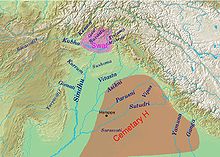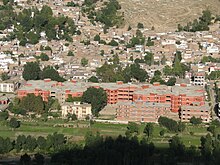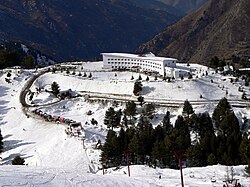Swat
Swāt : is a valley and an administrative district in the Khyber Pakhtunkhwa province of Pakistan. Centred upon the upper portions of the Swat River, Swat was a major centre of early Buddhist thought as part of the Gandhara kingdom, and today is littered with ruins from that era. Swat was home to the last isolated pockets of Gandharan Buddhism, which lasted until the 11th century, well after most of the area had converted to Islam.Until 1969, Swat was part of the Yusafzai State of Swat – a self-governing princely state. The region was seized by the Pakistani Taliban in late 2007,and its tourist industry decimated until after Pakistani suzerainty over Swat was re-established in mid 2009.[6]
Swat’s capital is Saidu Sharif, though the largest city, and main commercial centre, is the nearby city of Mingora. With a population of 2,309,570 according to the 2017 census, Swat is the third-largest district of Khyber Pakhtunkhwa, and is home of Nobel laureate Malala Yousafzai. The region is largely Pashtun, except in the valley’s uppermost reaches, where the Kohistani people dominate.
Swat is renowned for its outstanding natural beauty, and was described by Her Majesty Queen Elizabeth II as “the Switzerland of the East” during a visit to the region in the 1960s. Swat’s average elevation is 3,200 feet, resulting in a considerably cooler and wetter climate compared to most of Pakistan. With lush forests, verdant alpine meadows, and snow-capped mountains, Swat is one of the country’s most popular tourist destinations.
Etymology
Geography of the Rigveda; the extent of the Swat and Cemetery Hcultures are indicated.
A river named Suvastu is mentioned in the Rigveda. This may refer to the river Swat.[better source needed]
History
Mingora is the largest city in Swat.
In 327 BC, Alexander the Great fought his way to Odigram and Barikot and stormed their battlements. In Greek accounts these towns have been identified as Ora and Bazira. Around the 2nd century BC, the area was occupied by Buddhists, who were attracted by the peace and serenity of the land. There are many remains that testify to their skills as sculptors and architects. Later some Dilazak entered the area along with Sultans from Kunar and their tribe was styled as Swatis. The originator of the present family of Swat was the Muslim saint Akhund Abdul Gaffur, more commonly known as Saidu Baba. He was a pious man and the people respected him so greatly that they called him Akhund Sahib.[12][better source needed]
Buddhist heritage
An 1869 photo of a Buddha statue seated on a lotus throne in Swat Valley.
Historically known as Uddiyana, Tantric Buddhism flourished under King Indrabhuti, however, there is an old and well-known scholarly dispute as to whether Uddiyana was in the Swat valley, Orissa or some other place. Padmasambhava (flourished eighth century AD), also called Guru Rimpoche, Tibetan Slob-dpon (teacher), or Padma ‘byung-gnas (lotus born), semi-legendary Indian Buddhist mystic who introduced Tantric Buddhism to Tibet was, according to tradition, native from Uddiyana. He is revered as the second Buddha in Tibet. Padmasambhava is said to be the son of Indrabhuti, king of Swat in the early eighth century AD and one of the original Siddhas. Indrabhuti’s sister, Lakshminkaradevi, is also said being an accomplished siddha of the 9th century AD.
Ancient Gandhara, the valley of Pekhawar, with the adjacent hilly regions of Swat and Buner, Dir and Bajaur was one of the earliest centers of Buddhist religion and culture following the reign of the Mauryan emperor Ashoka, in the third century BC. The name Gandhara first occurs in the Rigveda which is usually identified with the region[15][page needed]
The Gandhara school is credited with the first representations of the Buddha in human form, rather symbolically as the wheel of the law, the tree, etc.
Hindu Shahi
Swat was ruled by the Hindu Shahi dynasty, who built an extensive array of temples and other architectural buildings, now in ruins. Sanskrit may have been the lingua franca of the locals.
Hindu Shahi rulers built fortresses to guard and tax the commerce through this area. Their ruins can be seen in the hills of Swat: at Malakand pass at Swat’s southern entrance.
Advent of Islam by Mahmud of Ghazni
At the end of the Mauryan period (324–185 BC) Buddhism spread in the whole Swat valley, which became a very famous center of Buddhist religion.
After a Buddhist phase the Hindu religion reasserted itself, so that at the time of the Muslim conquest (1000 AD) the population was solidly Hindu.
In 1023, Mahmud of Ghazni attacked Swat and crushed the last Buddhist King, Raja Gira in battle. The invasion of Mahmud of Ghazni is of special importance because of the introduction of Islam as well as changing the Chronology.
Arrival of Yousafzai
The first Muslim arrivals in Swat were Pakhtun Dilazak tribes from south-east Afghanistan. These were later ousted by Swati Pakhtuns, who were succeeded in the sixteenth century by Yusufzai Pakhtuns. Both groups of Pakhtuns came from the Kandahar and Kabul valley.
Taliban destruction of Buddhist relics
Swat Valley, located in the Khyber Pakhtunkhwa Province, has many Buddhist carvings, statues, and stupas. The town of Jehanabad contains a Seated Buddha statue. Kushan era Buddhist stupas and statues in Swat valley were demolished by the Taliban, and after two attempts by the Taliban, the Jehanabad Buddha’s face was dynamited. Only the Bamiyan Buddhas in Afghanistan, which the Taliban also demolished, were larger than the Buddha statue in Swat. The government did nothing to safeguard the statue after the initial attempt at destroying the Buddha, which did not cause permanent harm; when the second attack took place on the statue, the feet, shoulders, and face were demolished. Islamists (particularly the Taliban) and looters destroyed many of Pakistan’s Buddhist artifacts, which dated to the Buddhist Gandhara civilization. The Taliban deliberately targeted Gandhara Buddhist relics for destruction.Gandhara artifacts were thereafter plundered by thieves and smugglers.In 2009, the Archbishop of the Roman Catholic Diocsece of Lahore, Lawrence John Saldanha, wrote a letter to Pakistan’s government denouncing the Taliban activities in Swat Valley, including their destruction of Buddha statues, and their attacks on Christians, Sikhs, and Hindus. A group of Italians helped repair the Buddha.
Geography
Swat is surrounded by Chitral, Upper Dir and Lower Dir in the West, Gilgit-Baltistan in North Kohistan, Buner and Shangla in the East and south East. The southern tehsil of Buner was granted the status of a separate district in 1991. The valley of Swat is situated in the north of Khyber Pakhtunkhwa, and is enclosed by sky-high mountains.
Physical Features: Swat can be divided into two physical regions:
- Mountainous Ranges.
- Plains.
Mountainous Ranges
As mentioned above, Swat lies in the lap of mountainous ranges, which are the offshoots of Hindukush, so the larger part of Swat is covered with high mountains and hills, the crests of which are hidden by everlasting snow. Though these gigantic ranges run irregularly: some to the west while the others to the east, but the general direction is North-South.
Plains
The length of the valley from Landakay to Gabral is 91 miles. Two narrow strips of plains run along the banks of Swat River from Landakay to Madyan. Beyond Madyan in Kohistan-e-Swat, the plan is too little to be mentioned. So for as the width concerns, it is not similar, it varies from place to place. We can say that the average width is 5 miles. The widest portion of the valley is between Barikot and khwaza khela. The widest view point and the charming sight where a major portion of the valley is seen is at Gulibagh on main road, which leads to Madyan.
Economy
Approximately 38% of economy of Swat depends on Tourism and 31% depends on Agriculture.
Agriculture
Gwalerai village located near Mingora is one of those few villages which produces 18 varieties of apples due to its temperate climate in summer. The apple produced here is consumed in Pakistan as well as exported to other countries. It is known as ‘the apple of Swat’. Swat is famous for peach production mostly grown in the valley bottom plains and accounts for about 80% of peach production of the country. Mostly marketed in the national markets with brand name of “Swat Peaches”. The supply starts from April and continue till September because of a diverse range of varieties grown.
Demographics
The population of Swat District is 2,309,570 as per the 2017 census, making it the third-largest district of Khyber Pakhtunkhwa after Peshawar District and Mardan District. Swat is populated mostly by ethnic Pashtuns and Gujjar and Kohistani communities. The language spoken in the valley is Pashto, with a minority of Torwali and Kalami Kohistani speakers in the Swat Kohistan region of Upper Swat.
According to 1981 census, Pashto is main language and spoken by 90.28% of population while Kohistani is spoken by 8.67%.Kalami, Torwali and Urdu are also spoken by a fraction of population.
Tribes
Alongside the Gurjar Bakarwal people.
Administrative divisions
The District of Swat is subdivided into 7 Tehsils[35] i.e.
- Tehsil Babuzai
- Tehsil Matta
- Tehsil Khwaza Khela
- Tehsil Barikot
- Tehsil Kabal
- Tehsil Charbagh
- Tehsil Bahrain
Each Tehsil comprises certain numbers of Union councils. There are 65 Union councils in District Swat: 56 rural and 9 urban.
According to Khyber Pakhtunkhwa Local Government Act 2013.There were new system introduced called as Local Governments which have District Swat has 67 Wards, of which total amount of Village Councils is 170, and Neighbourhood Councils is 44.
Politics
The region elects three male members of the National Assembly of Pakistan (MNAs), one female MNA, seven male members of the Provincial Assembly of Khyber Pakhtunkhwa(MPAs) and two female MPAs. In the 2002 National and Provincial elections, the Muttahida Majlis-e-Amal, an alliance of religious political parties, won all the seats.
Tourist attractions
Marghazar
Sufid Mahal Marghazar Swat valley
Marghazar 16 km away from Saidu Sharif is famous for its Sufed Mahal the white marble palace built by the first Wali (ruler) of Swat. It used to be the ruler’s summer residence. Elizabeth II (Queen of England) and Prince Philip (Duke of Edinburgh) were also hosted there in 1961.The marble used to build White Palace was the same marble which was used to build Taj Mahal. It was turned into a hotel.
Fizagat Park
Fizagat Park is a recreation arena for the tourists and the locals situated at 1 kilometer from Mingora city. Situated along the bank of the River Swat, tourists enjoy bath and pleasant climate in summer.
Malam Jabba
PTDC Motel at Malam Jabba Ski Resort
Malam Jabba (also Maalam Jabba, Urdu: مالم جبہ) is a Hill Station in the lower Swat mountain ranges nearly 42 km from Saidu Sharif in Swat Valley, Khyber Pakhtunkhwa, Pakistan. It is 314 km from Islamabad and 51 km from Saidu Sharif Airport. Malam Jabba is home to the largest ski resort in Pakistan. On the main Madyan-Kalam road, the road turns to the right at Manglor town (12 km from Saidu Sahrif), for the Malam-Jabba Dara which has a series of small villages and settlements like Salanda, Jehanabad, Talegraam, Badar, Ser, Malam, Kishora, Spine Oba, and finally Jabba. Malam is a small village which comes prior to Kishora village on the main Malam-Jabba road. Malam is nearly 17 km from Manglor while Kishora is at 18 km distance. Jabba (12 km from Kishora) is the upper most part of the whole Dara (gorge). The Malam Jabba Ski Resort, owned by the Pakistani Tourism Development Corporation, had a ski slope of about 800m with the highest point of the slope 2804 m (9200 ft) above sea level. Malam Jabba Ski Resort was the joint effort of the Pakistan government with its Austrian counterpart. The resort was equipped with modern facilities including roller/ice-skating rinks, chair lifts, skiing platforms, telephones and snow clearing equipment. Unfortunately the resort was destroyed by the Taliban when they were in hold in swat valley. Now that writ of the government has been reinstated and peace established, tourism has picked up. The government of Khyber-Pakhtunkhwa(KPK) has awarded the tender for rebuilding the Malam Jabba skiing resort to a private company. Work is going on in full swing and is slated for a 2017 completion date. Skiing has already been restored and a skiing festival was held in Jan 2015.
Notable people
- Wāli of Swat
- Khan Bahadur of Jura
- Fateh Muhammad Khan
- Malala Yousafzai
- Justice Nasir ul mulk
- Afzal Khan Lala
- Miangul Aurangzeb Gujjar
- Malak Jamroz Khan
- Shaheen Sardar Ali
- Sherin Zada
- Rahim Khan
- Anwar Ali
- Mubarika Yusufzai
- Badar Munir
- Rahim Shah
- Nazia Iqbal
- Ghazala Javed
- Murad Saeed
See also
![Stupa_at_Shingardar_,_SWAT,Khyber_Pukhtunkhwa,_Pakistan[1] Stupa_at_Shingardar_,_SWAT,Khyber_Pukhtunkhwa,_Pakistan[1]](http://www.hkttreks.com/wp-content/uploads/2018/02/Stupa_at_Shingardar__SWATKhyber_Pukhtunkhwa_Pakistan1-366x275.jpg)









